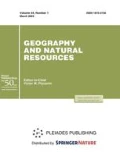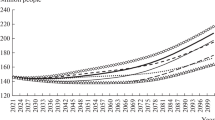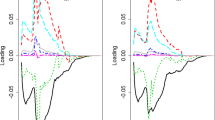Abstract
This article was prepared on the basis of on a number of Bayesian probabilistic forecasts according to the Population Division of the Department of Economic and Social Affairs of the UN Secretariat. The aim of the research is to forecast the population dynamics in Russia, Asian countries of the CIS, now referred to Central Asia, and East Asian countries from 2015 to 2095. The main research method is multifactorial simulation modeling. Consideration is given the changes in the population size of Russia as a result of the accession of Crimea and the growth of the migration inflow from the Territory of Ukraine. The forecast relies on demographic statistics (birthrates, mortality and migration exchange) in the region’s countries from 1950 to 2015. A brief review is provided for the dynamics of the dynamics of birthrate, mortality and pure migrations for separate countries of the region from the mid-20th century to 2015, and the forecast of these indicators (according to an average scenario) into 2095. Within the entire region, six forecast scenarios are considered, including the main (average) scenario. The first scenario implies the preservation (at the level of the year 2015) of the number of births in the age cohorts of females, the second scenario includes the preservation of mortality unchanged in the age cohorts of females and males, the third scenario involves a balance of migrations at the zero level, and the fourth and fifth scenarios provide a change in the number of pure migrations, with the birthrates and mortality remaining unchanged. The sixth scenario is treated as an average scenario. The population size by the end of the forecast period varies considerably with a particular scenario, but irrespective of the forecast scenario, a significant decrease in the population size is expected in Japan, China, South Korea and Russia. The largest increase in population by 2095 is forecasted for Tajikistan, Kyrgyzstan, Mongolia and Kazakhstan.
Similar content being viewed by others
References
Delovarova, L.F., Demographic Development of Kazakhstan and Main Directions of Modern Migration Policy, Narodonaselenie, 2016, vol. 1, no. 1 (71–1), pp. 75–82 [in Russian].
Maksakova, L.P., Demographic and Migration Potential of Uzbekistan, Narodonaselenie, 2016, vol. 1, no. 1 (71–1), pp. 83–89 [in Russian].
Kocherbaeva, A.A., Demographic Characteristics of Kyrgyzstan: Problems of Social Impacts and Future Action, Narodonaselenie, 2016, vol. 1, no. 1 (71–1), pp. 16–24 [in Russian].
Danilova, Z.A. and Bazarov, A.N., Demographic Forecast of Population in Baikalian Asia, Vestn. VSGUTU, 2013, no. 2 (41), pp. 123–127 [in Russian].
Bazhenova, E.S., New Aspects of the Demographic Situation in PRC, in The People’s Republic of China: Policy, Economy, Culture, E.G. Luzyanin, Ed., Moscow: Forum, 2014, pp. 192–209 [in Russian].
Bashlachev, V.A., A New Method of Measuring the Demographic Development on a Calendar Interval of 100 years, Pskov. Regionol. Zhurn., 2014, no. 19, pp. 97–112 [in Russian].
Kuklin, A.A., Bystray, G.P., Vasilieva, A.V., and Lykov, I.A., Forecast of the Russian Population Reproduction, Narodonaselenie, 2014, no. 4 (66), pp. 18–32 [in Russian].
Ryazantsev, S.V. and Horie, N., Demographic Development of CIS countries: Modern Tendencies, Forecast Values and Consequences, Vestn. TGUPBL. Ser. Obshchestnvennykh Nauk, 2010, no. 4, pp. 5–13 [in Russian].
Akimov, A.V., Long-Term Forecast of the Population Numbers and Prospects for Civilizational Interaction, Vostok. Afro-Aziatskie Obshchestva: Istoriya i Sovremennost’, 2009, no. 4, pp. 95–110 [in Russian].
Akimov, A.V., World Population Forecast up to 2050 and Labor Saving Technologies, Eastern Analytics. Annual 2014, Moscow: 2015, pp. 115–129.
United Nations, Department of Economic and Social Affairs, Population Division (2015). World Population Prospects: The 2015 Revision, DVD Edition. URL: http://esa.un.org/unpd/wpp/(Accessed 5.23.2016).
World Population Prospects: The 2015 Revision, Methodology of the United Nations Population Estimates and Projections, United Nations Department of Economic and Social Affairs Population Division, New York: United Nations, 2015.
Author information
Authors and Affiliations
Corresponding author
Additional information
Original Russian Text © A.G. Manakov, P.E. Suvorkov, 2018, published in Geografiya i Prirodnye Resursy, 2018, Vol. 39, No. 1, pp. 22-30.
Rights and permissions
About this article
Cite this article
Manakov, A.G., Suvorkov, P.E. Forecast of Demographic Processes in Russia and in Countries of Central and Eastern Asia in the 21st Century. Geogr. Nat. Resour. 39, 16–22 (2018). https://doi.org/10.1134/S1875372818010031
Received:
Published:
Issue Date:
DOI: https://doi.org/10.1134/S1875372818010031




